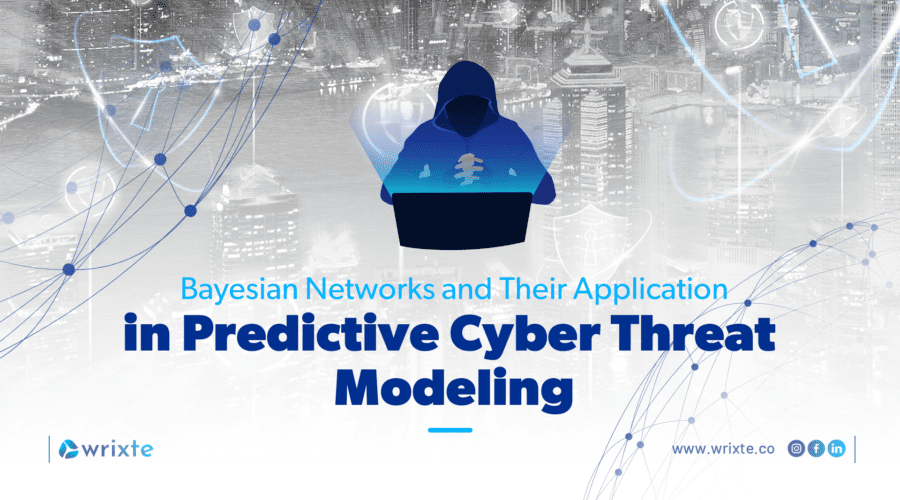In the realm of cybersecurity, the ability to predict and mitigate threats before they manifest is crucial. Bayesian Networks (BNs), rooted in probability theory and statistics, offer a sophisticated approach to predictive modeling in cybersecurity. By leveraging these networks, organizations can identify and preemptively address potential cyber threats with a high degree of accuracy. This blog delves into the advanced applications of Bayesian Networks in predictive cyber threat modeling, emphasizing their technical intricacies and industry relevance.
Bayesian Networks: An Overview
Bayesian Networks are graphical models that represent the probabilistic relationships among a set of variables. These networks are characterized by directed acyclic graphs (DAGs) where nodes represent variables and edges signify conditional dependencies.
Technical Foundations:
Nodes and Edges: Each node in a Bayesian Network corresponds to a variable, which could be an event or a piece of evidence. The edges between nodes indicate the direction of dependency and the strength of the relationship.
Conditional Probability Tables (CPTs): Each node is associated with a CPT that quantifies the effects of the parent nodes on the node itself. These tables are crucial for calculating the joint probability distribution of the entire network.
Bayesian Networks excel in handling uncertainty and incorporating new evidence, making them ideal for dynamic and complex environments like cybersecurity.
Bayesian Networks in Cyber Threat Modeling
In cybersecurity, Bayesian Networks can be employed to predict potential threats by analyzing historical data and identifying patterns that signify malicious activities.
Data Integration and Analysis:
Data Fusion: Bayesian Networks can integrate diverse data sources, such as network logs, user activity, and external threat intelligence feeds. This fusion of data provides a comprehensive view of the threat landscape.
Pattern Recognition: By analyzing historical data, Bayesian Networks can identify patterns and correlations that indicate the presence of a threat. This predictive capability allows organizations to detect threats before they escalate into incidents.
Example: A Bayesian Network might analyze network traffic patterns, user behavior, and known threat signatures to predict the likelihood of a malware infection. By continuously updating the network with new data, the model remains adaptive and responsive to emerging threats.
Advanced Applications of Bayesian Networks
Bayesian Networks offer several advanced applications in predictive cyber threat modeling, enabling organizations to enhance their threat detection and response capabilities.
Anomaly Detection:
Bayesian Networks can identify deviations from normal behavior, flagging potential anomalies that might signify cyber threats. By modeling normal network behavior, any significant deviation can be detected in real-time.
Attack Path Analysis:
Bayesian Networks can model the potential paths an attacker might take to compromise a system. By understanding these paths, organizations can prioritize defenses and allocate resources to protect the most vulnerable assets.
Risk Assessment:
Bayesian Networks can quantify the risk associated with different threats, allowing organizations to make informed decisions about their security posture. By evaluating the probability and impact of various threats, organizations can implement targeted risk mitigation strategies.
Incident Response:
Bayesian Networks can assist in incident response by providing a probabilistic framework for decision-making. During an incident, the network can help determine the most likely cause and suggest the best course of action based on historical data and current evidence.
Threat Intelligence Integration:
Bayesian Networks can integrate external threat intelligence feeds, enhancing their predictive capabilities. By incorporating real-time threat intelligence, the network can adapt to new and emerging threats more effectively.
Industry Applications and Statistics
Bayesian Networks have been successfully implemented in various industries to enhance cybersecurity measures. Here are some industry applications and relevant statistics:
Financial Sector:
Financial institutions use Bayesian Networks to predict fraud and detect insider threats. According to a report by the Ponemon Institute, the average cost of insider threats in the financial sector is $12.05 million per year. By employing Bayesian Networks, institutions can reduce these costs by proactively identifying and mitigating threats.
Healthcare:
In the healthcare industry, Bayesian Networks are used to protect patient data and ensure compliance with regulations such as HIPAA. A study by IBM Security found that the average cost of a data breach in healthcare is $7.13 million. Bayesian Networks help in predicting potential breaches and safeguarding sensitive information.
Government and Defense:
Government agencies use Bayesian Networks to protect critical infrastructure and national security. By analyzing threat intelligence and monitoring network traffic, these networks can predict and prevent cyber attacks that could have devastating consequences.
Conclusion
Bayesian Networks represent a powerful tool in the arsenal of predictive cyber threat modeling. By leveraging their ability to handle uncertainty and incorporate new evidence, organizations can enhance their threat detection and response capabilities. As cyber threats continue to evolve, the adoption of Bayesian Networks and their integration with advanced AI techniques will be crucial for maintaining robust cybersecurity defenses. For organizations aiming to stay ahead of the curve, investing in Bayesian Networks offers a strategic advantage in the ever-changing landscape of cyber threats.
